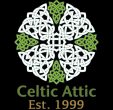By Kristin Olsen
Welcome the Way of the Celts, land of myth and fantasy. As we look to the magic and mysticism of the celtic lands, we discover that part of the magic we are drawn to might be the modern interpretation of what the ancient Celtic lands might have been. This is a portrait by modern writers and it is based on supposition. Most of Celtic history is verbal not written. This leaves the Emerald Isle of the ancients open to any revelation that our hearts, minds and souls see fit to gaze upon.
Can you picture in your minds eye the green rolling lands filled with Fairy folk, Dragons and Trolls? Are they purely fictional, as today’s society would portray? Can you envision it, is it possible! Let your imagination take you on a delightful journey into the land of faith and fantasy. Magic is something that is everywhere; it is a gift from the almighty (whatever that may be in your particular religious or spiritual path). For me the magic comes from my ancestors, their lands and beliefs. That magic also comes from the thought that a fairy may be sitting on my porch at this very moment giggling.
Lets take a stroll through the realm of Religion and Spirituality. Celtic spirituality has many faces. The Celts of old were obviously what would be termed a Pagan culture. They were pre-Christian and therefore there was really nothing else to be but what we now call Pagan. So did they worship multiple deities or did they simply pay homage and respect to the things of the earth that they could see and the things of the spiritual realm that they could not see? Did they name Gods and Goddesses and put a power or an attribute to these beings? Or did they simply thank the universe for the trees, land, streams, birds, animals and other things they needed and used in their everyday lives? Is it possible they were Spiritual without being Religious? This gives rise to many different religious philosophies that are in current use today. In reality, we can never truly know what was in their minds and hearts because they did not leave us a written record to preserve these early days.
When you study Ireland’s spirituality, St. Patrick is always discussed. Ireland is steeped with tradition. Some traditions are pre-Christian and some Christian. St. Patrick really helped head Ireland into modern Christianity by “Driving out the Snakes”. This saying basically means he converted Pagan Ireland to Christianity by silencing Paganism. It is a fascinating correlation as there really are no snakes in Ireland today. As we can see from modern spirituality, he didn’t actually silence Paganism. Indeed this spiritual path went underground and continued to flourish. Yet a great many of these Pagan ideas were used to teach Christianity in the Celtic lands.
The Irish have been able to successfully integrate some of the ideas and philosophies from the ancient times into their modern Christian religious philosophies. A grand example of this is St. Patrick’s use of the Shamrock to teach the pagan Irish about the Trinity. He explained the “Father”, “Son” and “Holy Spirit” to them utilizing the native flower of Ireland. The three petals represent the tree parts of one God. For the Shamrock are both one petal and three petals. Using the imagery provided by the shamrock, St. Patrick was able to show a very visual society the possibility of one God, Christianity.
The Shamrock was a sacred plant of the Druids because its leaves formed a triad. Three was a magical and spiritual number to the ancients because it represented: past, present, and future; and sky, earth, and underworld, Tír na nÓg (The Land of Youth). The explanation of the Shamrock should have made perfect sense to them, as they saw the number 3 as an integral part of their physical and magickal world.
Another great example is when St. Patrick introduced the idea of heaven to the early Celtics. They had tales steeped in tradition about Tír na nÓg (the celtic underworld or land of youth). It was considered a pleasant place and all wanted to visit this realm. Time stands still on Tír na nÓg. It is said to be and island to the far west of Ireland. One never grows old or suffers illness, flowers bloom never died in this land. No sorrow or pain, love is eternal, no wars or famine scar this land. So can you picture St. Patrick sitting on the Hill of Tara surrounded by the early Irish teaching them of Heaven and comparing it to Tír na nÓg? How easy it must have been for them to accept this concept. There are dozens of other examples, but we will leave those for later discussions.
Join me again for more tales of the Celtic Lands. We have much to discuss, The Book of Kells, The Otherworld, Tír na nÓg, Holidays, Runes, Goddesses, Gaelic and perhaps even a way to see Fairies in your everyday world or how to obtain the pot of Gold from that dreaded Leprechaun. Magic and Adventure is all around you, just close your eyes, open your heart and listen to your soul. Celtic Magic is everywhere. Visit me at http://www.celticattic.com
